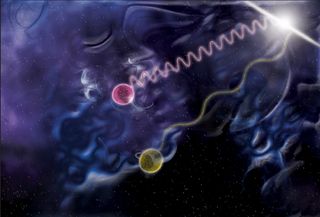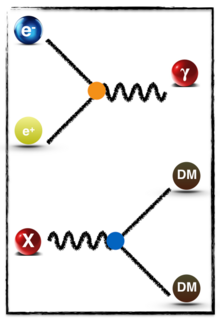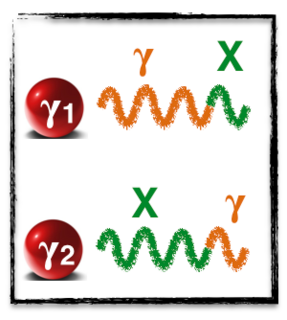Deciphering dark photons and dark forces
In my previous post, I mention the FASER proposal to track down potential new phenomena connected to the existence of dark forces (see here). In one of the comments, more explanations have been asked about the concepts behind dark forces, and more in particular about dark photons. I recall, for those who missed this older post, that dark photons are the carriers of the most simple dark force that could exist, dark electromagnetism.

[image credits: NASA]
As a result of these comments, here is a new post on the topic, where I hope things will get clearer. @justtryme90, please let me know whether things actually get better :)
In this post, I will come back to the concepts of dark photons and dark electromagnetism (to be defined below) and how they can be probed via their connection to the visible, non-dark, world.
For now, enough big words and let us enter the details!
MY STARTING POINT: DARK MATTER
I know I already discussed this many times, but once again does not hurt.
Assuming standard cosmology, the main matter part of the universe is made of dark matter. The latter consists of something that interacts gravitationally (like usual matter) but not electromagnetically. Consequently, dark matter is invisible (or dark), the wording dark corresponding to the fact that electromagnetism is related to light.

[image credits: APOD @ NASA]
Dark matter is a well motivated idea to explain many cosmological observations, but one must keep in mind that alternatives exist. In this post, I however follow this dark matter idea.
The next question consists on how we could add dark matter in the Standard Model of particle physics. Following a path on which the simplest thing is always the best, we divide the theory in two sectors.
We have one visible sector, that contains what we know (i.e. the Standard Model). We then also have another sector, that we call a dark sector and that we take minimal for simplicity. The latter includes a single particle species, the dark matter particle.
Note that the wording 'sector' is just a way to classify the particles in the theory. Nothing more nothing less.
However, one must also implement how the new dark matter particle interacts.
INTRODUCING DARK FORCES AND DARK ELECTROMAGNETISM
Following our principle of minimality, dark matter cannot interact through any of the three interactions of the Standard Model (electromagnetism, strong and weak interactions). This would either yield a non-dark dark matter or a modeling extremely complicated. We want to be simple here, although concrete complicated examples exist and work well.

[image credits: Pixabay]
If we take a dark sector only containing dark matter, we thus assume that dark matter cannot interact via any of the known interactions.
As a result, the only way dark matter would interact is via a new type of interactions. These new interactions are known as dark forces, and the simplest example is a dark copy of electromagnetism.
In order to explain how dark electromagnetism works, it is good to recall quickly how the usual electromagnetism interactions work at the level of the elementary particles.
For the sake of the example, let us take an electron and a positron.

[image credits: homemade]
On the picture on the right (the top panel), we have depicted the electromagnetic interaction of an electron (e-) and a positron (e+). One says that they interact electromagnetically via the exchange of a photon (𝛄).
The strength of this interaction (or the orange blob) is proportional to the electric charge of the electron and positron.
Similarly, we can build, at the elementary particle level, the dark electromagnetic interaction between two dark particles (DM) and model it as the exchange of a dark photon (X), as shown in the lower inset of the picture.
This time, the strength of the interaction (the blue blob) is proportional to the dark charges of the DM particle (that is arbitrary but will be fixed by measurements in case of a discovery).
To summarize where we are so far, we have the Standard Model particles interacting electromagnetically and a dark matter particle interacting dark-electromagnetically, but the visible and dark world are not connected. We hence cannot produce a dark photon or dark matter from visible matter, and vice versa.
MIXING PHOTONS AND DARK PHOTONS
The story however does not end here. When building a theory in particle physics, we rely on symmetries. The golden rule is that anything that is allowed by the symmetries must be present. Taking this into account, the photon and the dark photon are allowed to mix and thus mix.

[image credits: homemade]
This means that in nature, instead of having two particles 𝛄 and X, we have two particles 𝛄1 and 𝛄2 that both contain a little bit of photon and a little bit of dark photon.
This is illustrated on the left where we show the two force carriers: their photon component is orange and their dark photon component is green.
Both the 𝛄1 and 𝛄2 particles have a photon component, so that they will both interact electromagnetically. The amount of photons in 𝛄1 and 𝛄2 is smaller than 100%, so that the two particles will interact electromagnetically with a reduced strength.
Similarly, both 𝛄1 and 𝛄2 particles have a dark photon component and are thus interacting with dark matter. The dark interaction strengths are however reduced, as none of the 𝛄1 and 𝛄2 particles is 100% a dark photon.
MORE DISCUSSION AND REFERENCES
Supplementing the Standard Model of particle physics with dark electromagnetism is not very complicated. However, one important feature in the theory is that the particles responsible for mediating the electromagnetic and dark electromagnetic interactions mix.
However, electromagnetism is perfectly well measured by observations, and there is no track for darkness in there. The mixing is consequently tiny, well below the permil level. Therefore, 𝛄1 is a photon in a very good approximation, and 𝛄2 is a dark photon in a very good approximation. Let us thus identify the two particles as photon and dark photon again.
Even if the mixing is tiny, it has deep consequences: dark photons can be produced from interactions of the visible sector. This is super rare, but if we have billions of interactions, like at the LHC, once in a while, one may get a dark photon.
Conversely, dark photons are connected to dark matter, except in very rare cases were they could yield visible effects.
We have thus visible handles to produce and observe dark electromagnetism, if nature turns out to be darkly electromagnetic of course…
I hope all of this is now clear (or clearer). Please let me know in the comments!
Although this post is entirely coming from my own knowledge on the topic, more information can be found here.
For more discussion on this topic (or anything related to science), please join us on steemSTEM.
SteemSTEM is a community driven project which seeks to promote well written/informative Science Technology Engineering and Mathematics postings on Steemit. The project not only curates STEM posts on the platform, but also re-distributes rewards as STEEM Power to members of Steemit's growing scientific/tech community. More information on our actions is available here. You can also follow our curation trail to support us (contact us on the chat for practical details). We thank you for your generous support.
This makes things much more clear @lemouth. I think I grasp what you were trying to say in the previous post now. Thanks for breaking it down and providing the examples (and pictures). I understand how the forces are separated as they are generally unrelated to one another and are just a function of these two classes of particles.
We are able to detect a dark photon if one were to form in the LHC, due to the small amount of light electromagnetic character which is present?
Exactly. As the amount of normal photon inside is small, the events are rare. But then on needs to multiply by billions of bilions of collisions. Therefore, we will get some of them, hopefully enough to be able to see them.
I have got another statements said that "Dark was also not there. Dark is a state where there is no light. Light we can study, but not darkness. We can use Newton's prism to break light into several colors and study the various wavelengths of each color. But you can not measure the dark. How dark a room is measured by how much light intensity in the room is. Dark words are used by humans to describe the absence of light. "
The 'dark' in dark matter has nothing to do with colors. It is just a name, and the explication stems from the fact dark matter does not interact electromagnetically. I insist: this is the 'dark' in 'dark matter' and not the 'dark' as used in everyday's life.
Yes...that is great explaination..thanks
very interesting
Mesmerizing science...
Yes it is! ;)
Amazing information
I find it as well. I hope you liked it.
is that about science?
Of course! Particle physics to be more precise.
it's a good science, I also talk about science. but different, I understand more about the science of construction. your knowledge is very rare, I can learn a little about physics.
thanks @lemouth for replying to my comments, it's an honor.
I am always replying :)
And don't hesitate to join us on steemSTEM.
a very good offer. 😃
i will try to share in steemstem.
hopefully there is a view and useful for readers.
thank you @lemouth
I believe you may probably find a large bunch of potential readers in there. Hundreds of science aficionados are on the chat ^^
I’ve never ceased to learn something new from you. I think this post just elucidated the other post you made. Now I’ve got a better grasp of it. Thanks for sharing sir
My pleasure! :)
Your knowledge in particle physics is exceptional, totally amazing! I love science buy I only understand a portion of it, when it comes to topics like this; I'm like a little kid lol. Looking forward to more of your posts. I hope I can understand more about science through you. Thanks sir!
Don't hesitate to ask questions. I will be very happy to answer them, if I know the answer of course.
Thanks!